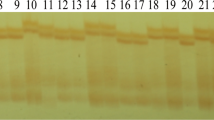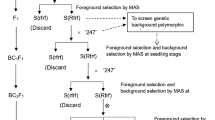Abstract
Following anther culture of various F1 hybrids of indica restorer (R) lines/wide compatible varieties (WCVs) and japonica R lines/WCVs, the homozygous diploid plants (2n) generated were test-crossed with indica WA type cytoplasmic-genetic male sterile (CMS) line Zhanshan 97A (WA), indica testers Nanjing 11 and Nante, japonica BT CMS line Hanfeng A (BT), and japonica testers Balilla and Akihikari to identify widely compatible restorer lines. The results of this study showed that among the diploid pollen plants generated from F1 hybrids of indica R lines/WCVs, 36.7% and 64.7% possessed normal fertility restoration ability (rate of seed-setting > 80%) to Hanfeng A and Zhanshan 97A, respectively. 71.3% and 32.3% had normal fertility restoration ability to Hanfeng A and Zhanshan 97A, respectively, in diploid pollen plants derived from the japonica R lines/WCVs F1's anther culture. Several widely compatible R lines were selected from anther culture of F1 hybrids of indica R lines/WCVs and japonica R lines/WCVs. These widely compatible R lines derived from diploid pollen plants showed good wide compatibility and restoration ability both to WA and BT type CMS lines. Strong standard heterosis of major agronomic traits and yield traits was observed in F1 test-crosses of widely compatible R lines with Hanfeng A and Zhanshan 97A. The wide compatibility in widely compatible R lines H17, H158 and H281 was studied by a set of three-way crosses. Segregation of the fertile plants with seed-setting rate > 70% and semi-fertile plants with seed-setting rate > 69.9% agreed with a ratio of 1:1, indicating that wide compatibility in these widely compatible R lines is governed by a pair of major genes.
Similar content being viewed by others
References
Hong, D., Y. Ma & Y. Tang, 1990. Genetics of fertility restoration ability in japonica restorer line Ninhui 3-2. Acta Agron Sin 16(1): 1–7.
Ikehashi, H. & H. Araki, 1984. Varietal screening of compatibility types revealed in F1 fertility of distant crosses in rice. Japan J Breed 34: 304–318.
Ikehashi, H. & H. Araki, 1986. Genetics of F1 sterility in remote crosses of rice. In: Rice Genet, pp. 119–130, IRRI.
IRRI, 1982. Annual Report for 1981. IRRI, Philippines.
Lin, S.C. & L.P. Yuan, 1980. Hybrid rice breeding in China. In: Innovative Approaches to Rice Breeding, pp. 35–51, IRRI.
Shi, M., 1985. The discovery and study of the photosensitive recessive male-sterile rice (Oryza sativa L., subsp. japonica). Sci Agric Sin 17(2): 44–48.
Shinjyo, C. & T. Omura, 1966. Cytoplasm-genetic male sterility in cultivated rice Oryza sativa L., I. Fertility of F1, F2 and offsprings obtained from their mutual reciprocal backcrosses and segregation of completely male sterile plants. Japan J Breed 16(Suppl): 179–180.
Shinjyo, C., 1975. Genetical studies of cytoplasmic male sterility and fertility restoring genes in rice. II. Varieties introduced from sixteen countries. Japan J Breed 22: 329–333.
Tanaka, I., 1984. Present and prospect of super high-yielding rice development. Agric Hort 59(1): 155–160.
Virmani, S.S., K. Govinda Raj, C. Casal, R.D. Dalmacio & P.A. Aurin, 1986. Current knowledge of and outlook on cytoplasmic-genetic male sterility and fertility restoration in rice. In: Rice Genet, pp. 633–647, IRRI.
Yang, R. & H. Lu, 1984. A preliminary analysis of restoring genes in restoring line IR24 of rice. Acta Agron Sin 10(2): 81–86.
Yang, Z.P., G. Shen, B. Liu, P. Han, L. Chen & Q. Chu, 1993. A study on inheritance of wide compatibility in rice varieties 02428 and Lunhui 422. Acta Agric Shanghai 9(2): 32–36.
Yang, Z.P. & Q. Chu, 1995. Studies on inheritance of photoperiod-sensitive genic male-sterile genes and its application on intersubspecific heterosis in rice (Oryza sativa L.). Acta Agric Shanghai 11(1): 27–32.
Yuan, L.P., 1990. Advances on hybrid rice breeding by two-line method. Sci Agric Sin 23(3): 1–6.
Yuan, L.P., 1991. Outlook on the development of hybrid rice breeding. In: Z.M. Xiong & S.K. Min (Eds.), Prospects of Rice Farming for 2000, pp. 205–211. Zhejiang Publishing House of Science & Technology, Hangzhou, China.
Zhang, Z., 1982. Application of anther culture techniques to rice breeding. In: Rice Tissue Culture Conference, pp. 55–61. IRRI, Philippines.
Zhou, J.S., Z.M. Wang & C.L. Wang, 1991. Utilization of wide compatibility gene in indica/japonica hybrid rice breeding. In: Z.M. Xiong & S.K. Min (Eds.), Prospects of Rice Farming for 2000, pp. 224–232. Zhejiang Publishing House of Sci & Tech, Hangzhou, China.
Zhou, T., J. Shen & F. Ye, 1983. A genetic analysis on the fertility of shan type hybrid rice with wild rice cytoplasm. Acta Agron Sin 9(4): 241–247.
Author information
Authors and Affiliations
Rights and permissions
About this article
Cite this article
Zhuping, Y. Breeding of widely compatible restorer lines in rice (Oryza sativa L.) through anther culture. Euphytica 95, 253–258 (1997). https://doi.org/10.1023/A:1002944827185
Issue Date:
DOI: https://doi.org/10.1023/A:1002944827185




